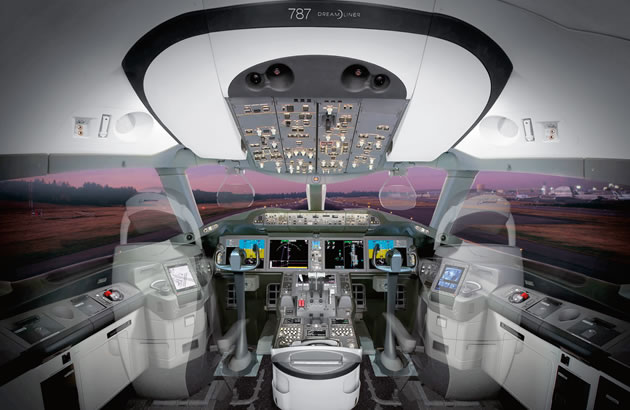
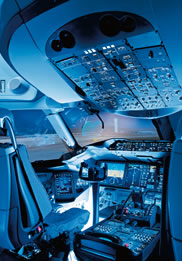
The flight deck of the new 787 Dreamliner introduces new technologies to help pilots work more efficiently and safely while maintaining significant operational commonality with previous generations of Boeing airplanes.
By Randy Neville, 787 Chief Pilot, and
Mike Dey, Manager, Flight Deck Product Development
The 787 flight deck has been designed to balance innovation, cost, and operational commonality with previous Boeing airplane models.
During the early development phase of the revolutionary 787 Dreamliner, the flight deck team was tasked with developing a design solution that would enhance safety while balancing innovation, cost, and operational commonality with previous Boeing flight decks. These key drivers were kept in the forefront as the team of engineers, pilots, and human factors experts took the initial flight deck concepts from paper layouts, to foam and cardboard ergonomic mockups, to functional prototype simulators, to final validation in full-scale hardware flight simulators.
Throughout the process, the design decisions and prototypes were shared with customer pilots and regulators for their input to help ensure that the key design drivers were properly balanced. As a result of these efforts, the 787 flight deck incorporates a number of innovative features that offer opportunities for airlines to save money and enhance their competitiveness while maintaining operational commonality with the 777.
This article describes the 787 flight deck and how its design can help improve airline operations.
Advanced flight deck technologies
The 787 advanced flight deck leverages state-of-the-art technology to improve operational capabilities and provide flight crews with a clean, simplified look and feel (see fig. 1). The flight deck integrates new technologies while maintaining a significant amount of commonality with other Boeing airplanes, especially the 777. Familiar Boeing controls, displays, and procedures all support shorter transition periods to the 787 from other Boeing family members and enable economical mixed-fleet flying.
Figure 1: The 787 flight deck
The 787 flight deck is designed for comfort, safety, efficiency, and commonality with the 777.
One of the 787 design goals was the ability to fly point to point to any runway end without the aid of ground navigation aids, and to do so with more flight crew situational awareness. By integrating dual global positioning system receivers with triple-redundant flight management systems, providing enhanced, simplified flight crew approach capability using the integrated approach navigation concept introduced on the Next-Generation 737, and including this information on the dual head-up displays (HUDs), the 787 offers the capability to reliably perform required navigation performance (RNP) procedures far into the future, improving operational efficiency.
Other advanced features include communications and datalink capabilities that extend the integrated future air navigation system design introduced on the 777, ensuring access to any airspace and providing a platform for operating in future Next Generation Air Transportation System and Single European Sky Air Traffic Management environments while retaining a consistent Boeing flight deck operational philosophy. Two identical integrated surveillance systems provide reliable weather radar, transponder, traffic collision avoidance system, and ground proximity functionality. This redundancy improves dispatch safety and reliability and also provides a platform for growth to support future air traffic initiatives, such as Automatic Dependent Surveillance-Broadcast (ADS-B).
The total number of parts in the 787 flight deck has been reduced compared to other airplanes. The three tuning control panels located in the flight deck aisle stand were developed for the 787 and replace functionality that previously would have required several independent control panels. This consolidates crew interface functionality for communication and surveillance systems, reducing the number of unique aisle stand panels and increasing backup capability. An electronic version of the control display unit (CDU) interface for flight planning functions has eliminated large and costly hardware multifunction control and display units from the flight deck while maintaining the user interface look and feel familiar to pilots of previous models.
One of the more dramatic simplifications of the 787 flight deck is a result of the 787’s “more-electric” architecture. Remote power distribution allows for the use of electronic circuit breakers, eliminating hundreds of physical circuit breakers from the flight deck. Flight crew awareness of system state is enhanced with visual information on every circuit interruption device, including those remotely located, via multifunction display (MFD) screens. The reduction in parts and improved design means lower operating costs and higher reliability. For example, the 787 requires just 13 line replaceable units (LRUs) to provide a full complement of flight deck display, communication, navigation, and surveillance capability. That’s about half as many LRUs as other models require for the same capability.
The 787 flight deck’s open avionics architecture design facilitates future upgrades, which can be made via software rather than more expensive hardware replacement or modification. “Soft-key” menus allow easier incorporation of technology upgrades by avoiding the need to install new physical buttons or switches into the LRUs. By design, future regulatory requirements and technology growth in areas such as communication, navigation, surveillance, and air traffic management will be easier to incorporate into the 787 flight deck.
The comfort of the pilots who will operate the 787 for decades to come was also a consideration of the design team. The pilot seats are designed to improve comfort, with additional adjustment capability. Acknowledging that the flight deck is the pilots’ workspace for many hours on end, the amount of storage in the flight deck for pilot luggage and personal items such as large water bottles was increased. Pilots will also enjoy expansive views from the 787’s large flight deck windows and appreciate the lowest noise levels of the fleet.
Other key flight deck features include:
Large multifunction displays. The 787 Dreamliner features the largest forward display screens of any certified airliner, with five MFDs that measure 15 inches diagonally (see fig. 2). The displays provide more than twice the area as those used on the 777, giving pilots more information and significant flexibility to tailor the display layout to their needs for each phase of flight. Standard features include an airport taxi map integrated into the forward navigation display, which enhances ground taxi safety and is a platform for future capability such as the display of ADS-B ground traffic in the airport environment.
Figure 2: Multifunction displays
The 787’s large multifunction displays give pilots more information and the ability to tailor the display layout to their needs for each phase of flight.

An enhanced vertical situational display provides a graphic rendering of approaching terrain profiles and a clear picture of the flight management system’s calculated and most efficient vertical flight profile, which supports RNP and continuous descent “green” approaches (see fig. 3). (For an explanation of RNP, see AERO second-quarter 2008.) The two outboard displays are a fixed format that provides primary flight display information combined with an “auxiliary” display that consolidates frequently referenced information for the crew, such as flight number, each pilot’s microphone-selected radio and its frequency, and transponder code. The lower portion of the auxiliary display is reserved for important datalink messages, such as controller-pilot datalink communications and digital automated terminal information.
Figure 3: Vertical situational display below navigation display
The enhanced vertical situational display provides a graphic rendering of approaching terrain profiles and a clear picture of the flight management system’s calculated and most efficient vertical flight profiles, supporting required navigation performance and continuous descent “green” approaches.
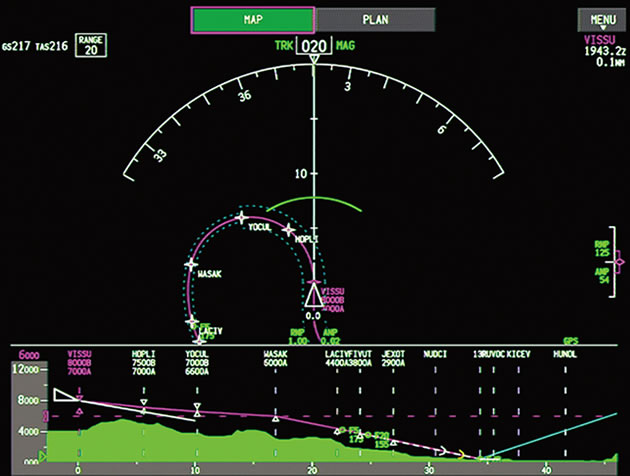
The three central MFDs can be split into independent formats or can be configured to provide a single large map. In addition to the navigation map, MFD formats include synoptic displays showing the state of major airplane systems, smart electronic checklists that integrate with airplane systems, an electronic CDU interface to flight management, and an area reserved for future growth. By consolidating numerous features, the large displays help reduce production and spares costs.
Dual electronic flight bags (EFBs). The 787’s dual Class III touchscreen EFBs pave the way for paperless flight operations (see fig. 4). Other airplane avionics, the flight management computer, communications, and flight deck printer all work with the EFBs. The EFBs enable significant reductions in the amount of flight deck paper by providing a standard software suite. This suite contains information such as maps, charts, manuals, onboard maintenance functions, a performance tool, and a document browser, which can all be updated wirelessly or with a maintenance laptop. It also allows takeoff-performance calculations to be made in real time and transmitted to the flight management computers.
Figure 4: Electronic flight bag
The electronic flight bag (EFB) is the digital equivalent of the pilot’s flight bag. Dual EFBs are standard on the 787.
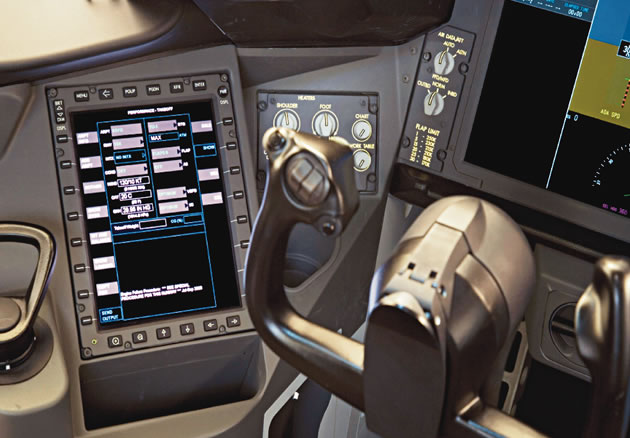
Dual head-up displays. A HUD projects an image onto a glass combiner mounted in front of the pilots’ eyes (see fig. 5). It displays flight information so pilots can look outside the flight deck, scanning for traffic or flying an approach, and simultaneously view primary flight instruments. The dual HUDs enhance safety in all phases of flight, in both good or poor visibility. HUDs also enable lower visibility takeoff minimums by integrating with the navigation radios and flight management system to provide low visibility takeoff runway centerline guidance. The dual HUDs allow the first officer to be proficient in HUD use when transitioning to captain.
Figure 5: Head-up display
The basic and dual head-up displays promote “eyes out of the flight deck” flying for both pilots.
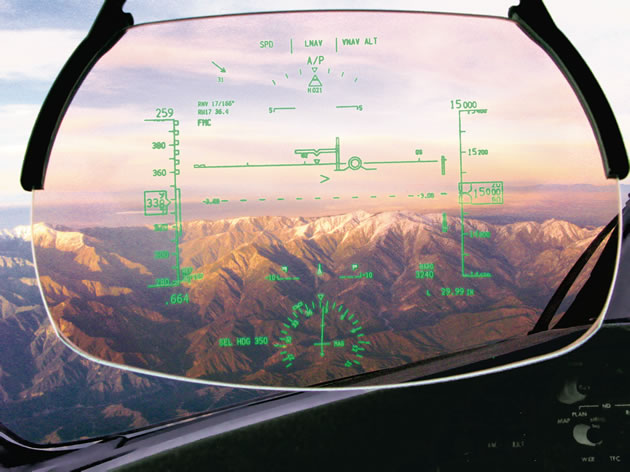
Operational commonality
Operational commonality is the similarity between airplanes in operating procedures, checklists, and flight crew interfaces. Commonality simplifies training and can decrease airline operating costs. To achieve operational commonality with the 777, the 787 team worked to ensure the new airplane would in many ways “feel” like a 777, while implementing new capabilities and simplifying the flight deck.
In the flight deck, commonality is created partly through the locations of displays, switches, and controls. One of the most notable decisions was to retain the traditional wheel-and-column pilot controls. Although the team studied other control mechanisms, including a side stick, a thorough analysis determined that the wheel-and-column arrangement provides the feedback and situational awareness pilots need to make and execute decisions during critical periods. On the 787, the wheel-and-column controllers:
- Are cross-linked between pilots to reduce potential confusion.
- Have large ranges of motion for improved peripheral cueing.
- Are back-driven to give pilots better visual and tactile understanding of what either the autoflight system or the other pilot is doing.
Advanced systems also help ensure that the feel of the airplanes is the same. The 787 digitally re-creates the feel and functionality of the 777, but takes advantage of innovations in fly-by-wire flight controls to reduce weight and improve performance. New functionality such as gust suppression helps create a smoother ride without changing the way the pilot operates the airplane. This approach allows the airplane to offer improvements in comfort and efficiency with minimal impact on flight deck procedures, reducing crew training costs in transitioning from other models of the Boeing fleet.
The advantage of commonality is particularly evident in the reduced Boeing training courses needed for pilots to be qualified as 787 pilots. For an existing 777 pilot, it takes as few as five days of training to transition to the 787. Pilots of 757s and 767s will need only eight days of training. Today’s 737 pilots will need 11 days of training for the 787. Pilots of other Boeing airplanes — 717, 727, and 747 — will need 13 days of training. Pilots with no experience in a Boeing flight deck will need 21 days of training.
Summary
The flight deck on the new 787 has been designed to balance innovation, cost, and operational commonality with previous Boeing airplane models.
For more information, please contact Randy Neville.


